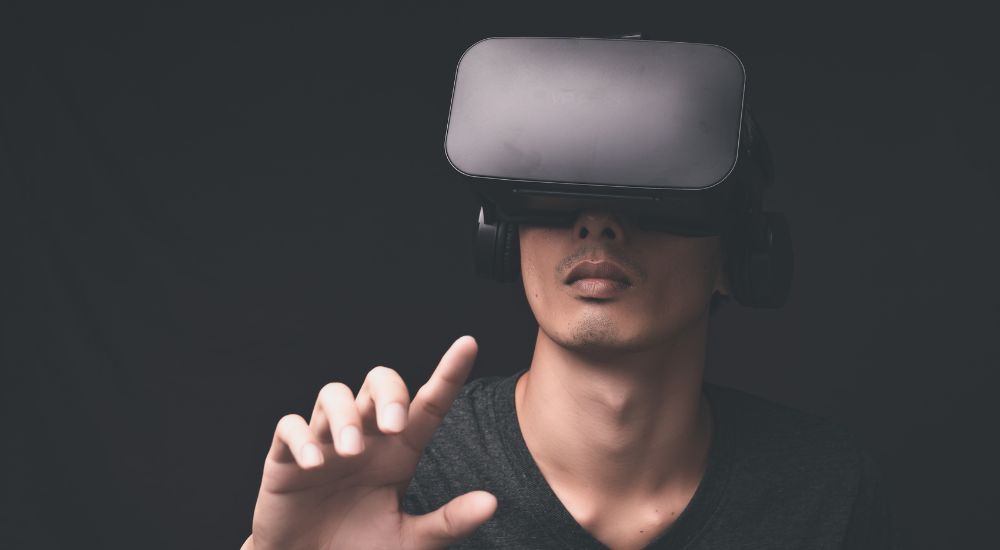Attempted several times in the past decades and once considered a gimmick, virtual reality (VR) has made a historic comeback in the recent years – and this time it’s here to stay.
With the increase in computing power of personal computers and the advances in potential gaming technologies, virtual reality has sprung back from its limbo and stole the headlines multiple times in the past years.
Recently, the term has been thrown around with the announcement of the Metaverse, an immersive digital world and a VR social platform. Or so they say.
Some developers have taken advantage of this technology and created games, showcasing it was possible to create immersive experiences using virtual reality. Thanks to this, there has been an increase in the number of people who are looking to learn how to make a VR game in Unreal Engine.
Yes, there still are some problems and limitations to work out, but virtual reality experiences are only getting better.
Whether you are a newcomer or a veteran in the game development industry, you might have considered jumping on the VR bandwagon, but one question remains: how to get started with VR game development?
In this article, we’re going to talk about what virtual reality is about, the pros of using Unreal Engine to develop your VR game and some pitfalls to avoid when working with this inspiring technology. Let’s jump right into it!
What is Virtual Reality?
Simply put, Virtual Reality (VR) is the use of computer technology to simulate a 3D environment that users can experience and interact with. Through the aid of special headsets with split near-eye displays, you users can look around and, with higher-end headsets, move around.
VR is present not only in the entertainment industry: it is gaining traction and is trending towards becoming a commonplace technology in education (for medical and military training) and business (for virtual meetings).
Virtual reality headsets usually come with special controllers that act as your hands, allowing you to pick objects up, throw them wherever your heart desires and, most importantly, interact with the world the computer is simulating.
One of its biggest selling points for games is the unprecedented ability to immerse oneself into the game’s world. Coupled with cutting-edge technologies currently in development, such as haptic feedback and general purpose AIs, virtual reality is set to become one of the biggest revolutions in the gaming industry – even bigger than the one brought by smartphones.

Types of Virtual Reality: stationary and room-scale
There are two different, but common types of VR headsets, which make for different VR experiences.
The cheapest and most basic form of VR is stationary. It allows you to look around in VR, but it doesn’t let you move your head. They usually come coupled with a small controller with basic functionality, allowing its users to play simpler VR games.
Nonetheless, it should still be a fun and immersive experience, but it can get better!
Some examples of stationary VR headsets include Oculus Go and Google Cardboard.
Room-scale, the other form of VR, is the most expensive, but also allows you to have the most immersive VR experiences. It’s different than stationary because it lets you move around the simulated world.
This kind of headset almost always come with motion-tracked controllers, enabling users to have even deeper interactions with the VR world.
Some examples of room-scale VR headsets include Oculus Rift, Oculus Quest and HTC Vive.
Pros of using Unreal Engine for Virtual Reality games
1. Visual scripting
If you are not well-versed on C++ programming, then Unreal Engine is a top choice. You will still require some programming logic to work with Blueprint, Unreal Engine’s visual scripting system that resembles a flowchart, but knowledge of the nuts and bolts that make C++ a complex language is not needed, letting you fully focus on working out the game logic.
2. Powerful graphics
It’s true that higher quality graphics require better processing power, which could pose some problems for VR players – more on this later. It’s also true that it’s harder to optimize Unreal Engine games compared to Unity, but you can achieve truly extraordinary visuals in Unreal if your computer is powerful enough, which increases VR’s immersion even further.
3. 100% open source
Unreal Engine is 100% open source, which means you have full access to the code at any given time and at no additional cost. You are allowed to modify and update your engine’s source code whenever and however you like, adding multiple layers of customizability to an already powerful game engine.
4. Render system
While the ability to write a complete high-level shader language (HLSL) isn’t built into Unreal Engine, it’s possible to take advantage of its material editor, which is node-based and allows you to make a wide variety of customizations.
Things to avoid while developing a Virtual Reality game
When it comes to the development of a virtual reality game, there are some pitfalls you must avoid. Headaches, eye strain and nausea caused by motion sickness are currently the most common issues with VR gaming.
It’s true, some people are fine with it, but many are very sensitive to the tricks being played by the VR headset on our senses.
One surprising factor that increase the odds of facing motion sickness when gaming in VR is not having a constant value of frames per second (FPS). Ideally, aim for 90 or higher by optimizing your game as much as possible.
To help you out, we’re going to list some things you need to keep in mind while developing your VR game.
Motion sickness
– Don’t move the camera unless the player is also moving;
– In the case you DO want to move your player around directly, make sure to either block their peripheral vision or put the player in a context where they are stationary, such as when piloting a car;
– When loading new areas or scenes, fade the screen out and then back in once everything is properly loaded;
– Regarding player movement, make them either move smoothly and responsively or teleport them around, making sure to apply the fade out and in to avoid disorientation.
Performance issues
– Merge actors when possible: there is no sense in merging multiple objects if only one is seen at any given time, but it’s better to merge them if they are always shown together;
– Turn on stereo rendering: if this option is disabled, each eye can be rendered separately, which can easily throw your player off and make them frustrated;
– Avoid extremely high resolution images: while bigger images make for better graphics, they can put too much load on GPUs, effectively slowing your game down;
– Level of Details (LODs): make farther objects appear with less details to make your game cheaper on both the CPU and the GPU. If you nail it, the player will barely notice a difference and your game will run much faster;
– Avoid using double-sided materials if the players will only see one side to save on rendering time;
– Use RenderDoc to debug and analyze your game frame by frame, which will help you pinpoint whatever is destroying your game’s performance.

We can develop your Virtual Reality game for you!
Now that you have a deeper understanding on how to make a VR game in Unreal Engine, the entire process seems daunting, doesn’t it? Developing virtual reality games is a complex and time-consuming process – more so than usual 2D/3D games.
Therefore, working with qualified professionals is one of the surefire ways to get your game up and running as fast as possible.
We are Main Leaf, a complete game development studio with over 70 professionals and hundreds of years in collective game development experience. We have been proving our expertise by creating fantastic games on demand since 2010 – and we would be pleased to do the same for you!
If you got interested and want to contact us for a discussion on your VR game, then make sure to head to the top of this page and request a game quote today. We will get back soon as we can!

